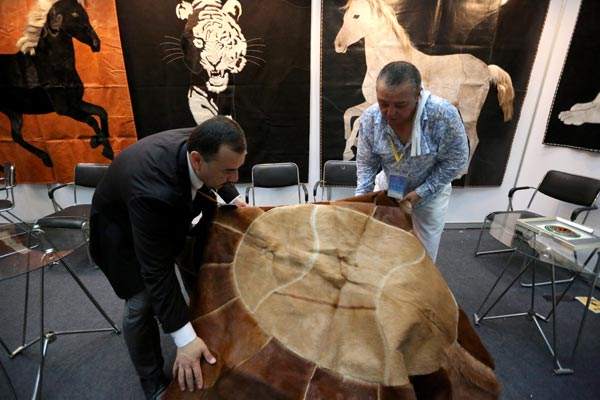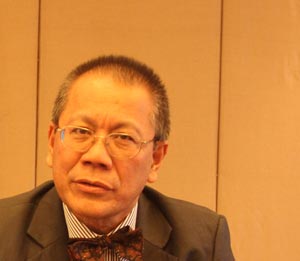|
 |
|
Entrepreneurs from Uzbekistan display furs at the expo. JIANG DONG / CHINA DAILY |
Planning process
Gansu province was an important region on the ancient Silk Road. "More than 1,600 kilometers of the ancient trade route went through the province, which was one of the route's most prosperous regions. Gansu is determined to exploit the opportunity to recapture former glories and make the province a 'golden section' of the proposed economic belt," Wang Sanyun, Party secretary of Gansu province, told team leaders from the member countries of the Asia Cooperation Dialogue in Lanzhou on Tuesday.
"In collaboration with the Development and Research Center of the State Council, provincial experts and related departments, Gansu has produced two reports. One is the Silk Road Economic Belt General Idea and Strategy report, and the other relates to strategic concepts to promote the proposed route," Zhang Shengzhen, secretary-general of the Gansu provincial government, said.
|
 The view from Hanoi First person | Sok Siphana The Silk Road Economic Belt will be a long corridor covering a vast area. Therefore, without connectivity, cooperation will be impossible. The concept of developing a "new Silk Road" is a very necessary one, and will benefit all the countries in Asia, especially those along the belt's route. The idea is to establish a modern economic corridor, and Cambodia plans greater cooperation with China in a number of fields, such as energy, especially solar power, to boost employment and help improve our infrastructure and Internet access. Cambodia has strong relationships with China in terms of the economy, politics and culture. The country will be one of the important routes of the Maritime Silk Road, and we hope to use our ports as transit centers for China and the other countries along the belt. China is a very important trade partner for Cambodia, but it seems that China benefits more from our bilateral trade. We hope Cambodia can play a role as a co-host to Chinese companies that have invested in the country. We need cooperation, not help, to develop. Cambodia will provide various kinds of support and offer favorable policies to all investors. SOK Siphana spoke with He Na and Xue Chaohua. |
The Xinjiang Uygur autonomous region, which neighbors Gansu, is also looking ahead. A number of regional departments, such as the local Development and Reform Commission, have formulated a program of opening-up and economic development to benefit from the proposed economic belt. Under the program, Xinjiang has suggested the construction of three major highways to serve areas in the north, south and center of China.
"Xinjiang borders eight countries, more than any other Chinese province or region. Its 5,600-km-long border is China's longest, accounting for 25 percent of the country's total land border. As an important portal for China to the outside world, Xinjiang will be developed into the core area of the proposed route," said Shi Dagang, vice-chairman of Xinjiang.
Pole position?
Farther south, Xi'an has vowed to become the starting point of the belt. "In November, we formulated a plan to accelerate the pace of construction to achieve that aim," Lou Qinjian, governor of Shaanxi province, said.
"President Xi's idea to build the Silk Road Economic Belt has far-reaching significance. We aim to make Shaanxi the starting point and are planning reforms that will facilitate the opening-up of inland provinces and regions. We hope to be the first choice for China's coastal regions, and other countries, for industrial transfers and transport. We want to be the largest logistics transit center and an important multicultural platform," he added.
As the geographical center of China, Shaanxi plays an important role in the country's trade with the West, so the province will focus on the advantages it enjoys, especially in the fields of fuel and raw materials, to deepen cooperation with countries along the route of the proposed belt, he added.
If it becomes a reality, the economic belt will bolster relations and connections along the route and benefit about 3 billion people. As such, the concept has been enthusiastically received by many countries along the proposed route.
"The concept of the economic belt as a successor to the ancient Silk Road has won support from many countries, including Tajikistan," said Zohidov Nizomidin, Tajikistan's deputy minister of Foreign Affairs.
Statistics from the Chinese Ministry of Commerce show that in 2013, the trade volume between China and four central Asian countries - Kazakhstan, Turkmenistan, Uzbekistan and Kyrgyzstan - rose 13 percent year-on-year to $40.2 billion, nearly 100 times that in 1992. China is the largest trading partner of Kazakhstan and Turkmenistan, and the second-largest of Uzbekistan and Kyrgyzstan.
"Turkmenistan hopes to increase cooperation with China and other countries in a number of fields, such as minerals, jewelry, energy and fruit," said Murat Annamammedov, a delegate from the Turkmenistan Federation of Entrepreneurs.
What is now Uzbekistan was one of the most important regions along the ancient route, and boosting the Silk Road Economic Belt is in the interests of modern-day Uzbekistan. "We completely support activities that promote trade and business. China is an important partner for us, and we welcome China to join an exposition that will be held in Uzbekistan in the near future," said Mamanov Fayzulla Bo'riyevich, chairman of the Tashkent Chamber of Commerce and Industry of Uzbekistan.
However, Zohidov Nizomidin, deputy minister of Foreign Affairs of Tajikistan, pointed out that the establishment and survival of the "new Silk Road" will require the combined efforts of all the countries involved to make full use of new technology. It will also require a huge amount of investment, both in terms of money and time.
Cooperation
"More importantly, we must trust each other completely, so the development can be realized through mutually beneficial cooperation. The Asia Cooperation Dialogue is a good platform and plays a very important role in promoting various kinds of cooperation," Nizomidin said.
Zhang Junkuo, deputy director general of the Development and Research Center of the State Council, pointed out that the planning process for the new route will need to be seen as a long-term project, and one that will require deep and extensive research to ensure that the needs of all the different regions and countries will be recognized.
"The planning must be scientific and practical, and should give priority to projects upon which all the countries have reached a consensus. The belt will be the focus of the interests of a number of countries, therefore, all the efforts must be undertaken on a mutually beneficial basis," said Zhang. "We will need to reduce any sources of business conflict among the different countries, and establish a high-level mechanism to resolve them as quickly as possible."
Contact the author at hena@chinadaily.com.cn
Lu Hongyan in Shaanxi contributed to this story.
